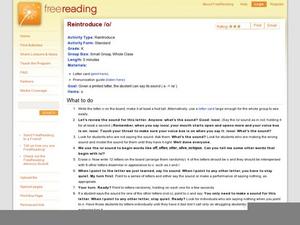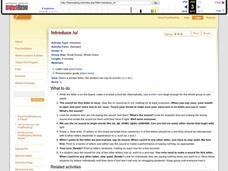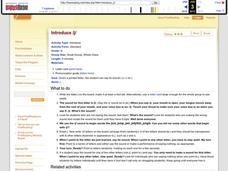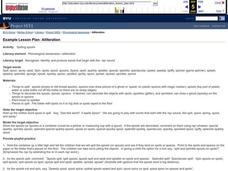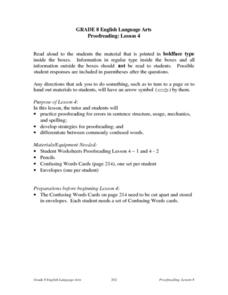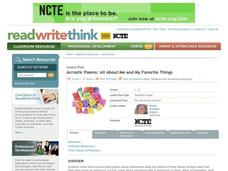Curated OER
Reintroduce /O/
Students study letters. In this letter identification instructional activity, students practice recognizing and making the sound for the letter "o." They work as a class to actively participate in various drills the teacher takes them...
Curated OER
Introduce /U/
Students study letters. In this letter identification lesson, students practice recognizing the letter "u" and pronouncing the sound it makes. They participate in various group activities practicing the use of the letter "u." This lesson...
Curated OER
Introduce /J/
Students determine how to write and say the sound of /j/. In this letter identification activity, students practice making the /j/ sound and write the letter after seeing it modeled. They locate the letter /j/ among others when they are...
Curated OER
Reintroduce /Z/
Students are reintroduced to the letter "Z" and review its sound. In this letter "Z" lesson, students review words that begin with the letter "Z" then think of other words that begin with the letter "Z" while they practice their...
Curated OER
Introduce /S/
Students determine when the letter s has been pointed out by the teacher and say its sound. In this phonics lesson, students learn the "s" sound and practice saying words beginning with the letter.
Curated OER
Introduce /Y/
Students are introduced to the letter "y" and practice its letter sound. In this letter "y" lesson, students review words that begin with the letter sound "y" and take turns reciting the sound of the letter "y."
Curated OER
Introduce /V/
Students are introduced to the letter "V" and its sound. In this letter "V" lesson, students practice saying the sound made by the letter "V" and touch their throats to make sure their voice boxes are on track. Students then review 12...
Curated OER
Alliteration
Students recognize, identify and produce words that begin with the /sp/ sound. They decorate objects that have the /sp/ sound with items that have the /sp/ sound. Students create phrases with the /sp/ sound that describe the object...
Curated OER
Double Jeopardy-Homophones
Second graders identify homophones as words that sound alike but have different meanings. They, given a pair of homophones, are to explain the meanings of the words using gestures, role playing, or drawing a picture with their partner.
Indiana University
World Literature: "One Evening in the Rainy Season" Shi Zhecun
Did you know that modern Chinese literature “grew from the psychoanalytical theory of Sigmund Freud”? Designed for a world literature class, seniors are introduced to “One Evening in the Rainy Season,” Shi Zhecun’s stream of...
BBC
The Patchworker - Sentences Making Sense
An entertaining and educationally sound lesson on sentence structure is here for you. Young readers play an online game called "The Patchwork Game" where they must patch together a series of words in order to create a complete sentence....
Curated OER
Nouns in a Story
Students, assessing a variety of formatting tools with Microsoft Word, utilize a bank of vocabulary words to make a personal dictionary of nouns. They classify nouns for people, places, things and ideas and separate them into common and...
Curated OER
Dr. Seuss’s ABC: An Amazing Alphabet Book Lesson
Dr. Seuss's ABC Book is used to help young readers distinguish between the letters of the alphabet and their letter sounds. After a discussion reviewing the letters that are vowels and consonants, the book is read to the class. Then, the...
Curated OER
Bounce into Speedy Reading: Growing Fluency and Independence
Increased reading comprehension begins with decoding and automatically recognizing words, which is the focus of this instruction. Using their choice of six different Winnie the Pooh stories, partners practice a variety of strategies...
Curated OER
Describing Paintings: Calm or Stormy
Young writers use nouns, verbs, and adjectives to describe details in two paintings. One depicts a sunny landscape, and the other shows a cloudier view. They write a narrative inspired by the paintings, paying attention to transitional...
Curated OER
Quick and Sticky Context Clues
Discuss strategies for defining word your young readers don't know. They read sentences with key words covered by sticky notes and guess from the context what the word might be. They peek at the first letter and guess again.
Curated OER
Alphabet Photo Book
Students brainstorm words that start with each letter of the alphabet, take digital pictures of words that start with assigned letter, and use iPhoto to create class alphabet book.
Curated OER
Rhythm and Rhyme
Youngsters listen to poetry and music to understand that words are made of sounds. In this rhythm and rhyme lesson, students create songbooks of healthy eating songs. They will also act out pantomimes and dance to the music....
Curated OER
Boogie Woogie with a B: Using Alliteration while Exploring Patriotic Tunes
Are you looking for a way to bring writing into your history instructional activity - or history into your writing instructional activity? This cross-curricular activity is helpful and fun, no matter what class you're teaching! Using...
Curated OER
Beginning Sounds: A is for Ant
The ABC's and beginning letter sounds are the foundation of strong reading skills. Use this presentation to build your young learner's abilities to recognize beginning sounds and alphabet letters. Each slide contains an image and a word...
Curated OER
Use Digital Photos of Scary Things to Inspire Poetry Writing
There's nothing like a provocative image to inspire a creative writing session. In the language arts instructional activity presented here, middle schoolers bring in digital photos of scary objects, such as a big spider, or a hornet's...
Curated OER
Proofreading: Lesson 4
Examine the key strategies to proofreading a piece of writing for errors in sentence structure, usage, mechanics and spelling. Eighth graders practice putting into correct passage commonly confused words (too, two, to) when writing to a...
Utah Education Network (UEN)
8th Grade Poetry: Sonnet Poem
The third instructional activity of five in an eighth-grade poetry unit has young scholars comparing Shakespearean sonnets with Petrarchan sonnets. To begin, they examine the different structures of the two forms and their different...
National Council of Teachers of English
Acrostic Poems: All About Me and My Favorite Things
Budding poets create two acrostic poems, one for their name and another using a word of their choice. Over the course of five days, scholars compose, revise, publish, and share their work with their peers.
